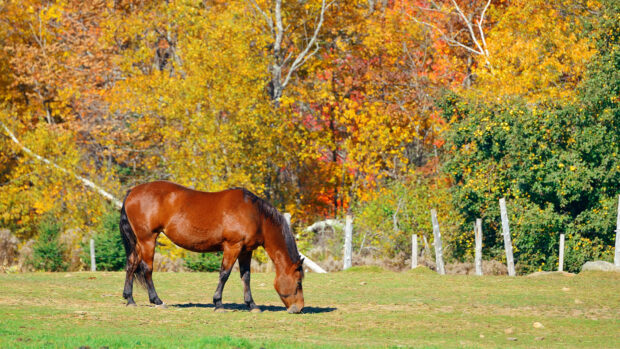Promotional Feature with Haygain UK
The ultimate goal for equestrians – and the one that generally leads to peak performance – is reaching the stage of your horse being a “happy athlete”. To achieve this, you must provide your horse with optimal training, healthcare and management that meet his individual needs.
Proper nutrition is at the heart of this effort. It provides the energy required for training and ensures good health from the inside out. The right diet also satisfies the horse’s need to spend the majority of their day consuming fibre, which is essential for their physical and mental health.
When sufficient grazing isn’t available, we turn to stored forage, such as hay or haylage, as the solution. Unfortunately, stored forage can also be a serious problem. In particular, dry hay – no matter how nutritious – can be a menace to the horse’s respiratory system and poses health risks to the handlers working in dust-filled areas, too.
This is where hay steamed by Haygain becomes the ideal core of most horses’ nutrition.
Soaked hay: a germ-packed meal
While soaking hay removes most of the airborne dust associated with dry hay, studies have shown that soaked hay quickly becomes a highly productive breeding ground for bacteria and mould.
Multiplying 150% within the first 10 minutes after soaking, the bacteria grows at alarming rates while the horse is still eating from the net. Horses often know instinctively what’s not good for them and many turn their noses away from soaked hay. They eat it only when there are no other options, and tend to consume it slowly – while the bacteria continues to multiply.
Meanwhile, the water used for soaking also removes the hay’s nutritional qualities. The result can be a poor quality, poor tasting, germ-packed meal for your horse. Plus, large volumes of toxic water returned to the environment as waste.

Haygain’s patented high-temperature steaming process is backed by scientific research.
The steaming solution
Evidence-based high-temperature hay steaming techniques provide a powerful solution to this conundrum, allowing for healthier airways, healthier guts, and a healthier environment.
The benefits of steaming hay are acknowledged and embraced by horse owners around the world. As a result, the market for hay steaming equipment is expanding.
Only one method of hay steaming, however, is backed by extensive scientifically-proven research – and that’s Haygain’s patented high-temperature steaming process. Developed in conjunction with the Royal Agricultural University, Cirencester, it injects steam evenly throughout the hay in a thermally sealed chest.
Haygain was introduced commercially in 2009 and it’s now relied on by Olympic equestrians including Scott Brash, Laura Tomlinson and William Fox-Pitt, along with proactive horse owners around the world.
Haygain steamers are proven to eliminate up to 99% of airborne particles, bacteria and mould commonly found even in forage of good nutritional content. Unlike soaking, the Haygain steaming process preserves the forage’s nutritional qualities and natural probiotics (the “good” bacteria that promotes healthy digestion).
A 2018 study showed that horses fed hay steamed in a Haygain steamer were 65% less likely to be diagnosed with inflammatory airway disease, a common condition on the equine asthma spectrum.
Horses also really like the taste of Haygain-steamed hay. Haygain studies confirm that most prefer it to dry hay, soaked hay and haylage. With up to three times the moisture content of dry hay, Haygain-steamed hay supports hydration and healthy digestion, too.
As for the environment, Haygain steamers use minimal water, and the steaming process kills toxins rather than letting them seep into the waste water.

Many studies have been conducted to compare dry, soaked and steamed hay.
The science
As the standard of care throughout the equestrian industry, Haygain steamers have history and science on their side. There are a few different ways to steam hay these days, but only one method with extensive science and the success stories of thousands of horses supporting it.
Here are a few highlights of the research establishing Haygain’s benefits. Read the full summaries at haygain.co.uk
Forage palatability and preference
Steamed hay is preferred over soaked and dry hay (Owens et al., 2019)
Steaming hay increased the amount eaten, without affecting the rate of intake and amount of chewing (Pagan et al., 2015)
Given the choice, horses preferred steamed hay over dry hay or soaked hay, and that steamed hay was always the first to be consumed once tasted (Moore-Colyer and Payne, 2012)
Steamed hay was the first fodder chosen by horses and they consumed more steamed hay than either haylage or dry hay (Brown, Tracey and Gowers, 2013).
Presence of respirable particles and bacteria
Steaming hay in a Haygain reduces airborne respirable particles and microbial contamination, while conserving mineral and protein content in hay. It is suitable for providing hygienically clean forage to stabled horses (Moore-Colyer, Taylor, and James, 2016)
Steaming hay reduces mould, bacteria and fungi by 99%, while soaking increases bacteria drastically (Wyss and Pradervand, 2016)
Soaking hay for nine hours followed by steaming for 50 minutes in the Haygain is the most effective method for reducing water-soluble carbohydrates and microbial contamination in hay (Moore-Colyer et al., 2014)
Steaming is the most effective way to reduce both aeroallergens and bacteria from hay (Daniels, Hepworth and Moore-Colyer, 2020)
When measuring respirable dust levels, a combination of shavings and steamed hay produced the lowest levels in both American barn and individual stable designs (Moore-Colyer and Auger, 2017)
Steaming was the most effective treatment for reducing respirable particle numbers, mould and bacteria contents, thereby improving the hygienic quality of the hay. In contrast, soaking was shown to increase the bacterial content of the hay thereby decreasing the hygienic quality of the hay (Moore-Colyer and Fillery, 2012)
Both freshly steamed haylage and four-day old steamed haylage had lower bacteria and mould contents than when the bale was freshly opened (Leggatt and Moore-Colyer, 2013)
When steaming four types of hay for 50 minutes in the HG1000, respirable particles were reduced by 94%. The reduction was still 79% of that found in dry hay 24 hours later (Stockdale and Moore-Colyer, 2010)
Signs of disease
Feeding horses Haygain steamed hay could reduce the incidence of inflammatory airway disease by 65% (Dauvillier, ter Woort and van Erck-Westergren, 2019)
Horses diagnosed with RAO showed less clinical signs when fed steamed hay compared with dry hay (Blumerich et al., 2012)






